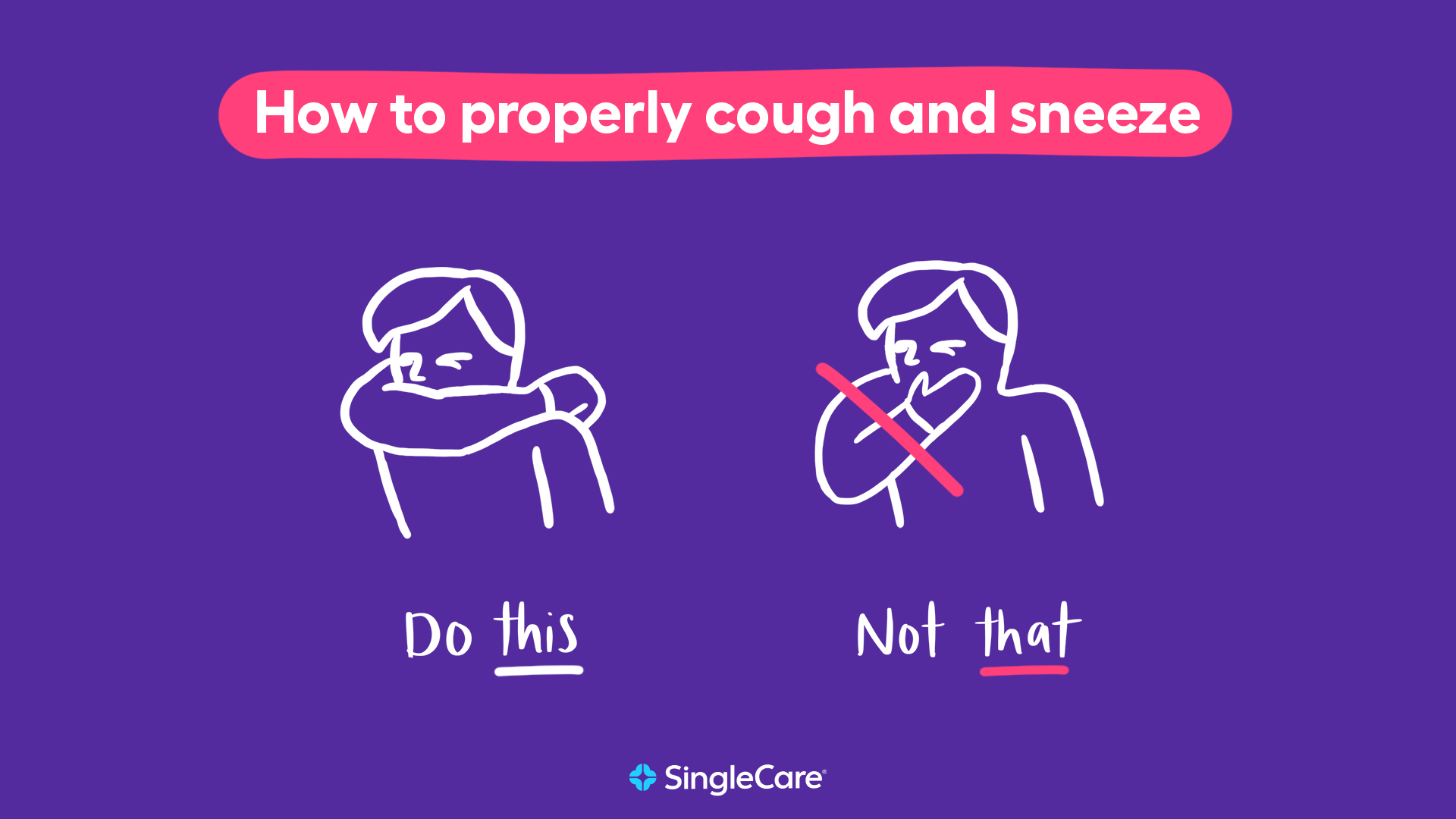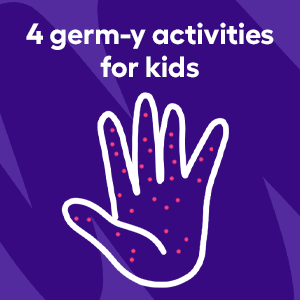Key takeaways
Explain germs to children in simple, understandable terms, emphasizing that they’re invisible but can still cause illness.
Teach children to prevent the spread of germs by covering coughs, keeping distance, not sharing personal items, and getting vaccinated.
Highlight the importance of handwashing and the correct use of hand sanitizer to prevent the spread of germs.
As summer winds down, teachers and parents across the U.S. are bracing themselves for one seemingly inevitable side effect of the start of the new school year: kids spreading germs and getting sick. It’s a good time to start teaching (or reminding) kids about good health habits to reduce the spread of those nasty viruses—including stomach bugs, the flu, COVID-19, or even a common cold.
6 strategies for teaching kids about germs
So, it’s up to you to start teaching kids about germs in the hopes that you can reduce or even prevent the spread of some of those illnesses. Here’s how to approach the discussion of kids and germs.
1. Explain germs in easy-to-understand terms
Adults know that there are a number of different kinds of organisms that can cause disease: bacteria, viruses, protozoa, and even fungi. It’s understood that some germs spread through the air, while others are spread through contact with bodily fluids, such as saliva, mucus, or blood. While you can’t see those germs, they’re definitely out there, just waiting to wreak havoc.
That can be a hard message to convey to young children. Simple, clear language is best for communicating facts about germs to kids. Tell younger children: “You can’t see them, but they can still make you sick,” suggests Danelle Fisher, MD, pediatrician and chair of pediatrics at Providence Saint John’s Health Center in Santa Monica, California
For example, you can explain that if you sneeze, cough, or sniffle, invisible germs float off into the air. Other germs need you to do a little more work for them. To spread those germs around, you might have to touch your mouth or nose and then touch someone else. (With older children, you can get into more detail, of course.)
2. Make it fun—and relatable
Germ education doesn’t have to be boring, and it shouldn’t be. If you start talking about protozoa, kids are likely to zone out. Instead, use comparisons that really make sense to your child, based on their current life experience. Try one of these activities to bring invisible germs to life:
- Glitter germs: By the time kids reach elementary school, they’ve enjoyed using glitter for an art project or two. Try this experiment: Put glitter in one child’s hand, and instruct the child to interact with other people, just like they normally would do in school. “By the end of the day, everyone had glitter everywhere,” says Elizabeth Clark, RN, nursing education and practice specialist for the National Association of School Nurses (NASN). The glitter is just like germs.
- Pepper bowl: Sprinkle pepper on top of a bowl of water. Ask a child to dip a finger into the bowl, and watch the pepper cling to your child’s hand. Then ask kids to wash their hands with soap and dip a soapy finger into the bowl. The pepper is repelled. Explain how the pepper is just like germs.
- Germ model: Germ education is all about making the invisible visible. Sculpt a germ model out of clay or playdough. Attach eyes and give it a name. Then, place it somewhere that kids need a hygiene reminder—like near the bathroom sink.
- Pass the bread: Show your child what happens when you touch something with dirty hands. All you need is a few pieces of bread and some time. Have kids handle one slice with freshly washed hands and another slice with dirty fingers. Then, put the bread in a bag and wait. Spoiler alert: One of the pieces will develop a yucky green mold. “That really brings things to life,” Clark says. If you don’t have time to wait, watch the experiment on YouTube.
Some kids need a visual aid to really understand that invisible germs can cause real problems. You know you got your point across when you hear a good, “Ewwww!”
Download and print these activities for your kids below.
3. Talk about ways to avoid germs
Next, you can focus on action. You should teach or remind them of ways to help prevent the spread with certain behaviors. For example:
- Cover your cough: Kids should cover their mouths when they have to cough or sneeze to reduce the chances that they’ll spread germs to their classmates and teachers.
- Keep your distance: “Children can also understand as they get older to stay away from people who have symptoms, people that are coughing or sneezing or vomiting,” Clark explains. After social distancing for the last year, giving people six feet of space may feel more natural.
- Avoid sharing certain items: That means no swapping sips of juice, and keeping items that may be in contact with your mouth or nose to yourself. If your child chews on pens or pencils, remind them not to pass those items to classmates.
- Get vaccinated: After you teach your child about how germs spread, you can talk with them about why vaccination is important and prepare them for any vaccines they might need such as the flu shot, COVID-19, or a tetanus booster.
You can also refer to the Centers for Disease Control and Prevention’s recommendations for ways to reduce the spread of viruses.

4. Emphasize the importance of handwashing
Washing your hands can prevent the spread of germs that cause disease—all sorts of diseases, not just COVID-19. You can teach your kids both how to wash their hands correctly and when to do so.
First up: the how. Show your children how to wash their hands by doing it with them. Show them how to use soap and lather up their hands and scrub all surfaces of their hands, including in between their fingers. Explain that they need to spend at least 20 seconds on this task. “Sing the alphabet at normal speed,” suggests Dr. Fisher. “That’s 20 seconds.” Or, pick your child’s favorite tune, and sing along as a family.
Next is the when. The CDC maintains a list of key times to wash hands, which among others includes:
- Before and after eating
- Before, during, and after preparing food
- After using the toilet
- After coughing, sneezing, or blowing your nose
- Before and after touching a cut or wound
“Parents can reinforce when they see their kids washing their hands without prompting by saying ‘Good for you,’” says Dr. Fisher. “There are things that we should reinforce as parents and caretakers.” And let your children see you washing your hands correctly, too. “We definitely need to model good behavior,” says Fisher.
5. Address the need for hand sanitizer
Sometimes, soap and water aren’t available. By now, most kids are probably well acquainted with hand sanitizer, but it’s a lesson still worth repeating. Remind your children that they can use a dollop of hand sanitizer when they can’t wash their hands. Many schools are stocking hand sanitizer in multiple locations, so coach your child to always look for the hand sanitizer—and use it when there’s not a sink readily available for handwashing.
Just make sure to go over hand sanitizer safety with small children. Ingesting even a small amount can lead to poisoning. It can be toxic for young kids when using too much, and applying improperly can lead to skin issues or eye injury.
RELATED: Does hand sanitizer expire?
6. Incorporate lessons in daily life
When you go to get a vaccine, explain that it’s a way to help keep you safe from germs. As you put in a load of laundry or wash the dishes, tell kids how cleaning can reduce the spread of viruses. If children take a daily vitamin, explain how vitamin C helps to strengthen the immune system. When you go for an evening walk, explain how getting outside and staying active is good for your health. The more you repeat the message and bring it to life, the more likely kids are to remember next time they find themselves in a situation to avoid germs.
- What are germs? Nemour Kids Health (2023)
- How to protect yourself and others, Centers for Disease Control and Prevention (2025)
- About handwashing, Centers for Disease Control and Prevention (2024)





